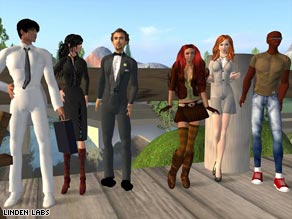Last Friday, I was in London and read the Times and the Guardian. In both newspaper I found an article about a couple that was going to divorce because the husband had a virtual affair on Second Life. Googling the Internet, I was astonished to find loads of comments, starting with Lewis Wallace's blog, who got plenty of comments, FoxNews and CNN. Is this event worth the press it gets? In an older article MSNBC asks the question whether a virtual affair is real-world infidelity? And there lays to me the real question.
A couple hours later, I received an invitation to attend a Second Life conference about eco-friendly innovation to take place on December 4th. A banner nicely explains how you can build your avatar, or that you can request a pre-made avatar by e-mailing a specific address. I don't know what I will do yet, but this last point made me think.
Indeed, the newspaper articles contained photos of the couple as well as of their avatars. And guess what, there was not really a resemblance between both. If you can also "borough" an avatar for a conference, how do you ensure you are you in Second Life. This question may sound silly when you are speaking about video games, or whether, as adults, you may want to have fun. I will not even start discussing the danger of having children and teenagers being put in contact with unknown people.
 But frankly, to use this tool as a collaboration tool, it is critical that you know who you are dealing with. You need be able to trust the other people with whom you are working. Information will be exchanged, strategies will be exposed, points will be discussed, how sure are you the other people are who they pretend to be? You may argue that this can also happen in real life, when you meet somebody previously unknown to you. Most often you develop a protocol to recognize each other, like holding the good old newspaper. On TV people are not who they are supposed to be, but how often does this happens in real life.
But frankly, to use this tool as a collaboration tool, it is critical that you know who you are dealing with. You need be able to trust the other people with whom you are working. Information will be exchanged, strategies will be exposed, points will be discussed, how sure are you the other people are who they pretend to be? You may argue that this can also happen in real life, when you meet somebody previously unknown to you. Most often you develop a protocol to recognize each other, like holding the good old newspaper. On TV people are not who they are supposed to be, but how often does this happens in real life.
In Second Life it seems to happen way more. Indeed, for many people, Second Life seems to be the place where they enact their fantasies, where they pretend to be somebody else, and where they live their dreams. Our society may have a need for such environment, I do not dispute this. But, frankly, I have difficulties imagining this environment to also serve as a global collaboration tool. It is difficult for me to imagine mixing real work and fantasies. And even if people can make the difference, using the same tool may make it difficult for them not to flip-flop between both. I would strongly recommend to separate both thoroughly.
No comments:
Post a Comment